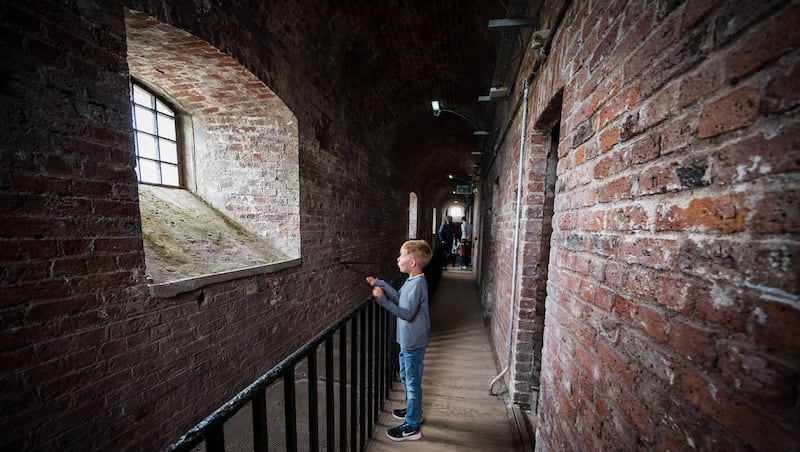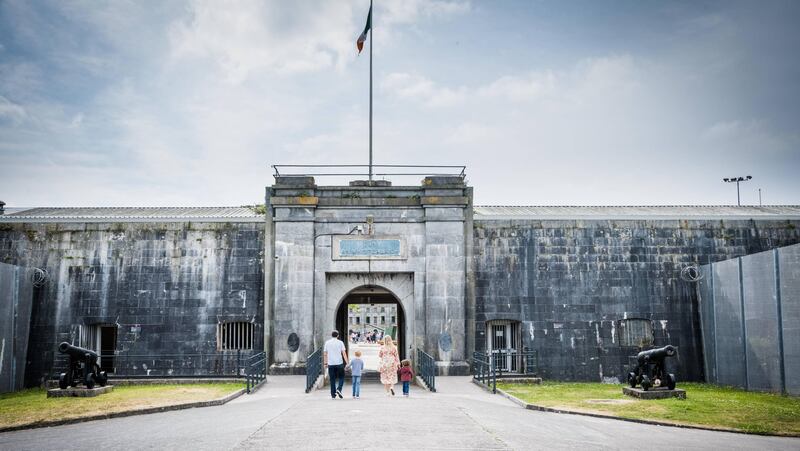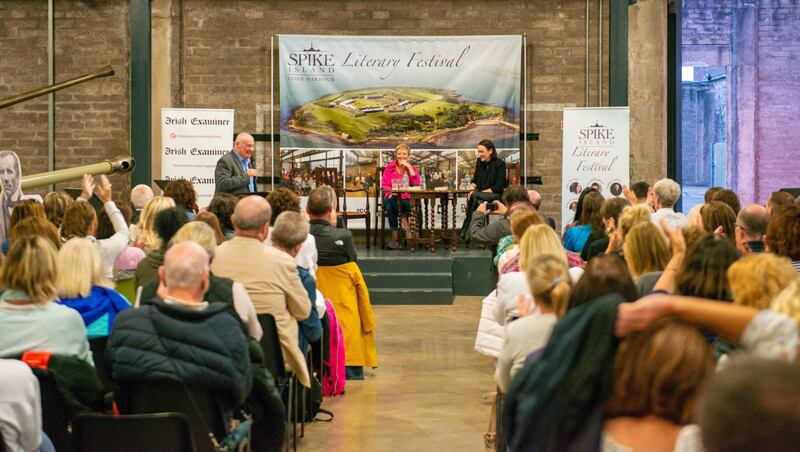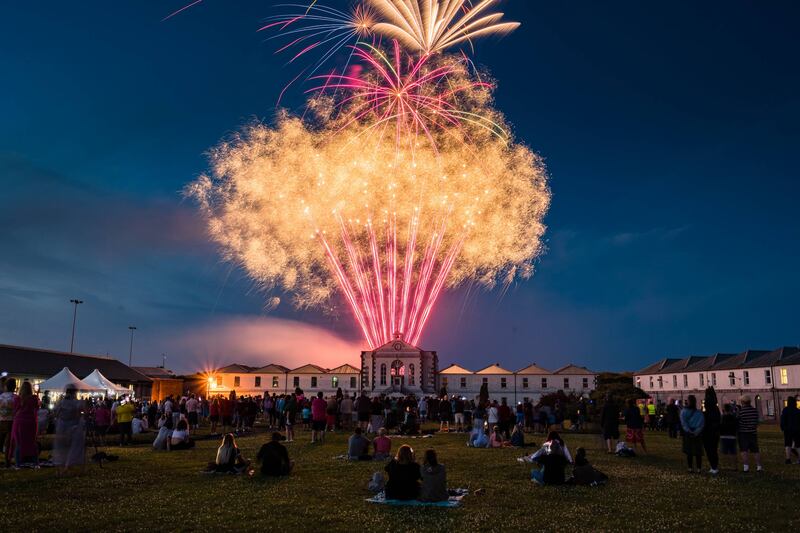Spike Island has always been a place that deals with its own duality beautifully.
Despite being just a ten-minute ferry ride away from the bustling town of Cobh, the island feels totally separated from the ‘real world’, with a trip to Spike often feeling like a journey into the past, where visitors are transported all the way back through the island’s 1,300 plus years of Irish history.
The greater contradiction, however, is that while much of that history is utterly tragic, chronicling everything from the Famine years to the War of Independence, a trip to Spike Island is always a fun day out. How is it that getting to explore what was once the world’s largest prison — and recounting just how painful Ireland’s journey to independence was — is not only a sombre experience, but also one that consistently sees visitors both young and old leaving with a smile on their face?

“Getting the balance right is really important to us,” explains Michelle Russell, Spike Island’s marketing manager. “I suppose people think of Spike Island primarily as a prison, but it actually started out as a seventh century monastery and at one point was an impressive military fort built to defend Cork Harbour. Most famously it went on to become the world’s largest prison during the 19th century and remained in various states of use throughout its lifetime. It’s hard to believe now when you walk through the gates but it was still operating as a prison as recently as 2004.″
Why an SSE Airtricity energy audit was a game changer for Aran Woollen Mills on its net-zero journey
Getting solid legal advice early in your company’s journey is invaluable
Water pollution has no one cause but many small steps and working together can bring great change
Empowering women in pharma: MSD Ireland’s commitment to supporting diverse leadership
With Spike Island having stood witness to so many vital parts of Irish history, it’s only natural that some periods are less pleasant to recount than others. “Parts of the history here are heart-breaking; the punishment block in particular can be quite harrowing,” Michelle reflects. “There’s still an air to it of all the terrible things that happened inside the block in the 1800s, it was really not a nice place to be. There’s also what was known during the Famine years as the children’s prison, which held people who were arrested for small crimes like stealing food. Around that time, it was also used as a convict depot, housing prisoners who were sentenced to transportation overseas. There would have been children as young as 13 years old incarcerated there, which is quite a disturbing thought. Those are the things that do stand out to our visitors.”

A rich social history
“However, in spite of the harrowing stories from our history, there is also a rich social history attached to the island with many holding happier memories of their time here. Throughout our military history, members of the Irish and British army would have been stationed on Spike and their families lived with them here on the island, contributing to a special microcosm of Irish social life. We actually have a group of volunteers who join us every Tuesday, they all have a connection to the island with many having grown up here and their stories are fascinating. Many of their original homes are still here on this island, as well as their church, their school - they went about daily life, growing food, attending mass and socialising together. I suppose it’s alien for the rest of us think of growing up here but to them it was normal life and for many, all they’d ever known and they missed island life after they left.”
As well as these bright spots from history that tell of happier times at Spike Island, there’s also plenty of joy to be found on the island in the present day. “We have a lovely café on site here serving hot and cold sandwiches and delicious cakes as well as a gift shop where you can pick up a souvenir of your visit,” shares Michelle. “There are also some beautiful walking trails around the outer island with breathtaking views of Cobh and Cork Harbour, which we recommend visitors take the time to enjoy. We’ve recently added a children’s playground and a kid’s history trail, where they get to explore and wander around with their little map and participate in a fun quiz. We’ve also had our fairy fortress trail for a few years now, which is still really popular with the little ones, but we felt the older kids weren’t getting the full benefit of that, whereas these new additions have a wider appeal.”

Breathing new life into the island
There are also plenty of family fun events planned for the coming months, each set to breathe new life into the island. “We are continuing to diversify our offering at Spike Island in terms of different events, so we have some exciting concerts and events coming up that we’ll be announcing shortly. The big date in the calendar this summer is our annual Independence celebrations on 8 July, which commemorate the handover of Spike Island from British to Irish rule. It’s a great day out with something for all the family, including fireworks, music performances and more. Those who don’t get their hands on the much coveted tickets tend to flock to the likes of Cobh and Crosshaven to watch the fireworks from afar, so it’s a really nice community event.
“We also had our first literary festival on Spike Island last year, which was a great success attracting budding writers and avid readers alike as well as our regular visitors. The festival returns this August with a really exciting programme and line-up and details will be announced very soon.”

With so much going on at Spike Island, it’s no surprise that people from all over the world are travelling to visit. “There’s about an 80/20 breakdown of our visitors at the moment, with 80 per cent of them being domestic tourists from across Ireland and the other 20 per cent being international visitors from all corners of the globe,” Michelle explains. “The international market is really bouncing back since the pandemic, as we’ve got the cruise liners coming into Cobh again. We work with a number of international tour operators who bring visitors from as far as the US with a strong audience also coming to us from the UK and throughout Europe too.”
Expert storytellers bring past to life
Like so many other great tourist attractions, however, Spike Island remains relatively unexplored by those who live just a stone’s throw away. “It’s a weird one, but I always think if something’s on your doorstep, you’re less likely to go for some reason. It’s interesting that when I mention Spike Island, the amount of Cork people who will turn to me and say, ‘Oh I’m mortified, I’ve never been.’ When they do come they’re actually taken aback by how much there is to see and do here; they regret not visiting sooner,” Michelle laughs.

This sense of surprise at the sheer vastness of Spike Island is familiar for all visitors. After all, Spike’s fort alone is so large that the whole of Alcatraz island could fit inside.
“A typical visit to Spike Island takes three-and-a-half hours in total, and people really do need all that time if they want to see everything at a relaxed pace. We recommend our visitors take the guided tour on arrival at the island. Our guides really are expert storytellers and they bring the island’s past to life so vividly and with such passion and integrity,” Michelle advises. “If you want to stop for a bite to eat in the café, or go for a stroll around the outer island, it’s very easy for the time to fly by!”
With family tickets starting from just €59, including a return ticket for the idyllic ferry from Cobh, you can get a full day out for the whole gang at great value. Who knows, mammy and daddy might even learn something new while they’re there too.
To book tickets this summer, and find out more about Spike Island, visit their official website.





